I have an SFH235 ir photo-diode (which datasheet can be found here) and only basic knowledge of electronics.
I want to connect the photodiode to an Arduino (the grand-plan is to add an ir diode and build a distance sensor).
I understand that photodiode produce current, and it produces more current the more intensive the light that falls on it.
I have seen schematics that connect photodiodes the same way that photoresistors are being connected. Others connect it to an "opamp"(why?) And that are also those articles that say I need to amplify the current. I have also seen capacitors added into the circuit.
Which is the correct way for my application? How can I connect the photodiode to the analogue input of Arduino (which measures voltage)?
